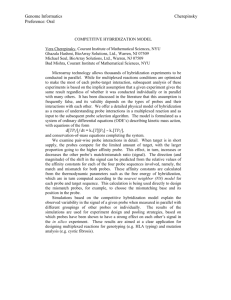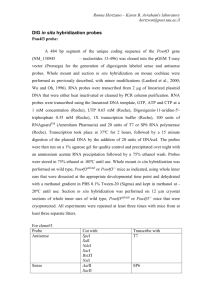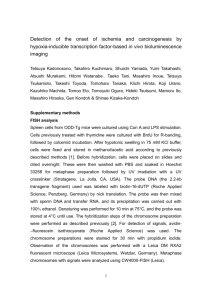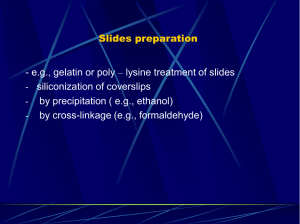In situ protocol in situ
advertisement
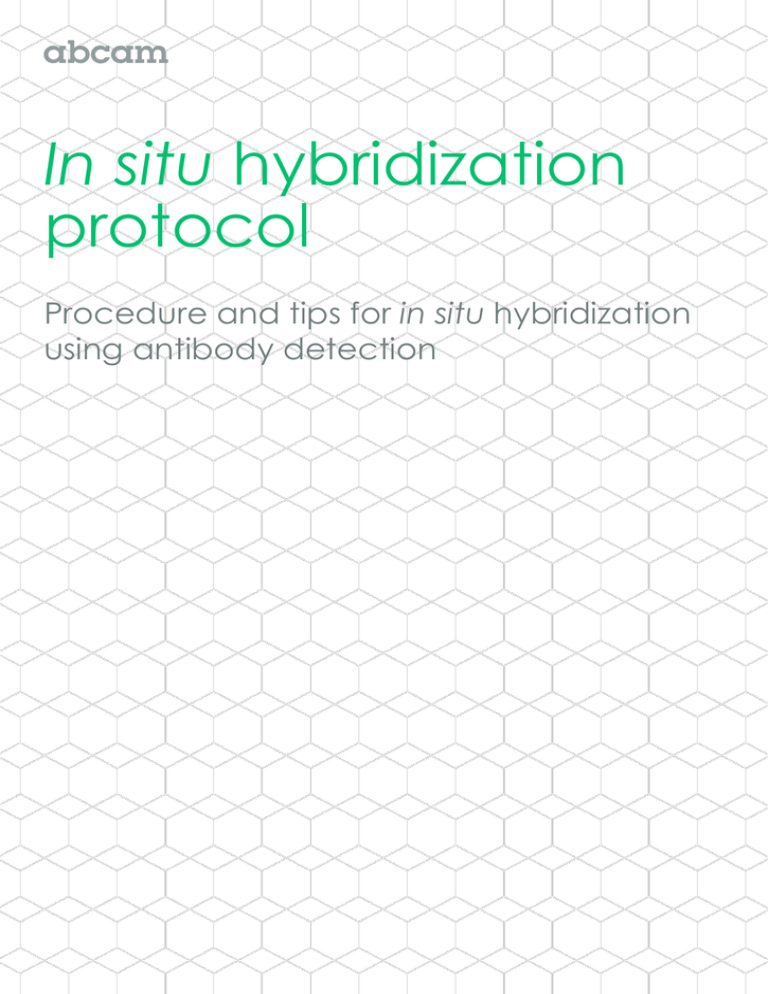
In situ hybridization protocol Procedure and tips for in situ hybridization using antibody detection In situ hybridization protocol Introduction In situ hybridization identifies where in the cellular environment a gene is expressed. A labeled RNA or DNA probe hybridizes with a target mRNA or DNA sequence in a sample. The probe is then detected using an antibody. Sample storage RNA preservation Preserving RNA is made difficult due to presence of RNase enzyme. This enzyme is found on glassware, in reagents and on operators and their clothing. RNase quickly destroys any RNA in the cell or the RNA probe itself so users must ensure they use sterile techniques, gloves, and solutions to prevent RNase contamination of the probe or tissue RNA. General sample storage when using frozen sections For best results on older slides, do not store slides dry at room temperature. Instead, store in 100% ethanol at -20°C, or in a plastic box covered in saran wrap at -20°C or -80°C. Such storage preserves slides for several years. Choice of probe RNA probes RNA probes should be 250–1,500 bases in length; probes of approximately 800 bases long exhibit the highest sensitivity and specificity. Transcription templates should allow for transcription of both probe (antisense strand) and negative control (sense strand) RNAs. Clone into a vector with opposable promoters to achieve this. Circular templates must be linearized before making a probe, though PCR templates can also be used. DNA probes DNA probes provide high sensitivity for in situ hybridization. They do not hybridize as strongly to target mRNA molecules compared to RNA probes, so formaldehyde should not be used in the post hybridization washes. 2 Probe specificity is important. If the exact nucleotide sequence of the mRNA or DNA in the cell is known, a precise complementary probe can be designed. If >5% of base pairs are not complementary, the probe will only loosely hybridize to the target sequence. This means the probe is more likely to be washed away during wash and detection steps and may not be correctly detected. Digoxigenin (DIG)-labeled RNA probe in situ hybridization protocol This protocol describes the use of DIG-labeled single-stranded RNA probes to detect expression of the gene of interest in paraffin-embedded sections. 1. Deparaffinization For frozen sections, start at Step 2. If using formaldehyde-fixed paraffin-embedded sections, continue with this step. Before proceeding, slides must be deparaffinized and rehydrated. Incomplete removal of paraffin can cause poor staining of the section. Place the slides in a rack and perform the following washes: – – – – – – – Xylene: 2x3 min Xylene 1:1 with 100% ethanol: 3 min 100% ethanol: 2x3 min 95% ethanol: 3 min 70 % ethanol: 3 min 50 % ethanol: 3 min Rinse with cold tap water Keep the slides in the tap water until antigen retrieval. From this point onwards the slides cannot dry as this will cause non-specific antibody binding and high background staining. 2. Antigen retrieval Digest with 20 µg/mL proteinase K in pre-warmed 50 mM Tris for 10–20 min at 37°C. Incubation time and proteinase K concentration may require optimization. We recommend trying a proteinase K titration experiment to determine optimal conditions. Insufficient digestion will reduce hybridization signal and over-digestion will result in poor tissue morphology, making localization of the hybridization signal very difficult. Optimal proteinase K concentration will vary depending on the tissue type, length of fixation and size of tissue. 3. Rinse slides 5x in distilled water. 4. Immerse slides in ice-cold 20% (v/v) acetic acid for 20 sec. This permeabilizes the cells to allow access to the probe and the antibody. 5. Dehydrate the slides by washing for approximately 1 min per wash in 70% ethanol, 95% ethanol and 100% ethanol, then air dry. 3 6. Add 100 µL of hybridization solution to each slide. Final concentration Amount to use per 1 ml of solution 50% 500 µL Salts 5x 250 µL Denhardt's solution 5x 50 µL 10% 100 µL 20 U/mL 10 µL 0.1% 1 µL Reagent Formamide Dextran sulphate Heparin SDS Salt solution (20x) – – – – – 4 M NaCl 100 mM EDTA 200 mM Tris-HCl pH 7.5 100 mM NaH2PO4.2H2O 100 mM NaH2PO4.2H2O Denhardt’s solution (100x) – – – – 10 g Ficoll 10 g PVP (polyvinylpyrrolidine) 10 g bovine serum albumin (BSA) 500 mL sterile dH2O 7. Incubate the slides for 1 h in a humidified hybridization chamber at the desired hybridization temperature. Typical hybridization temperatures range between 55– 62°C. 8. Dilute the probes in hybridization solution in PCR tubes. Heat at 95°C for 2 min in a PCR block to denature the RNA or DNA probe. Chill on ice immediately to prevent reannealing. 9. Drain off the hybridization solution. Add 50–100 μL of diluted probe per section, covering the entire sample. Incubate in the humidified hybridization chamber at 65°C overnight. Cover the sample with a cover slip to prevent evaporation. During this step, the RNA probe will hybridize to the corresponding mRNA, or the DNA probe will hybridize to the corresponding cellular DNA. Optimize the hybridization temperature depending on the sequence of the probe used, as well as the cell or tissue type. This temperature should be optimized for each tissue type analyzed. Optimal hybridization temperature for probes depends on the percentage of bases present in the target sequence. The concentration of cytosine and guanine in the sequence are important factors. 10. Stringency washes 4 Solution parameters such as temperature, salt and detergent concentration can be manipulated to remove non-specific interactions. – – – – To prepare 1 L of 20x saline sodium citrate (SSC) 175.3 g NaCl (3 M) 88.2 g sodium citrate 800 mL sterile dH2O Adjust to pH 5 using citric acid, fill to 1 L and autoclave – – Wash 1 50% formamide in 2x SSC 3x5 min, 37–45°C Wash away excess probe and hybridization buffer with higher temperatures (up to 65°C) for short periods of time. If left too long this can wash off too much of the hybridized probe RNA/DNA. – – Wash 2 0.1–2x SSC 3x5 min, 25–75°C This step removes non-specific and/or repetitive DNA/RNA hybridization. Follow these guidelines to optimize temperature and salt concentration for stringency washes: – For very short DNA/RNA probes (0.5–3 kb) or very complex probes, the washing temperature should be lower (up to 45°C) and the stringency lower (1–2x SSC). – For single-locus or large probes, the temperature should be around 65°C and the stringency high (below 0.5x SSC). – The temperature and stringency should be highest for repetitive probes (such as alpha-satellite repeats). 11. Wash twice in MABT (maleic acid buffer containing Tween 20) for 30 min at room temperature. MABT is gentler than PBS and is more suitable for nucleic acid detection. To prepare 5x MABT stock – 58 g maleic acid – 43.5 g NaCl – 55 g Tween-20 – 900 mL water Bring the pH to 7.5 by adding Tris base. About 100 g will be required. Bring final volume to 1 L. 12. Dry the slides. 13. Transfer to a humidified chamber and add 200 µL blocking buffer to each section (MABT + 2% BSA, milk or serum). Block for 1–2 h at room temperature. 14. Drain off the blocking buffer. Add the anti-label antibody at the required dilution in blocking buffer. Check the antibody datasheet for a recommended concentration/dilution. Incubate for 1–2 h at room temperature. 15. Wash slides 5x10 min with MABT at room temperature. 5 16. Wash the slides 2x10 min each at room temperature with pre-staining buffer (100 mM Tris pH 9.5, 100 mM NaCl, 10 mM MgCl2). 17. For fluorescence detection, proceed to Step 18. For other forms of detection, return the slides to the humidified chamber and follow manufacturer’s instructions for color development. 18. Rinse slides in distilled water. 19. Air dry the slides for 30 min. Wash in 100% ethanol and air dry thoroughly. 20. Mount using DePeX mounting solution. 6
